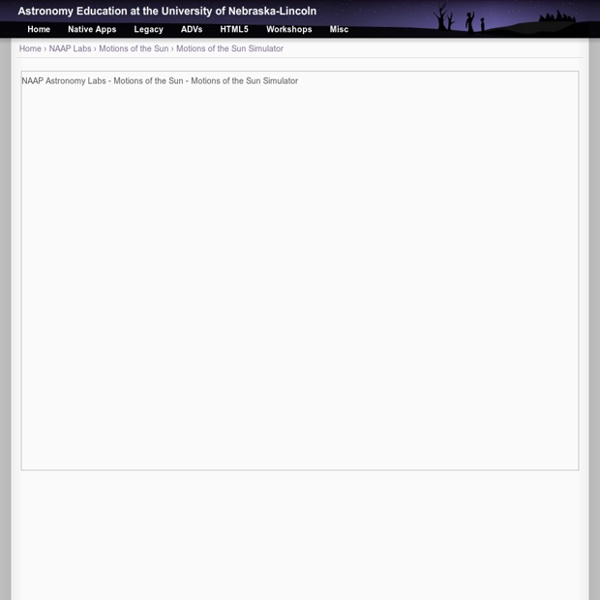



Warholizer: Turn digital photos of you and your friends into pop First time here? Welcome! We have a lot of fun stuff to play with like ourMotivational Poster maker, Magazine Cover maker, Pop Art poster, and much more! Play as much as you like—everything is free. We also sell awesome custom-printed products. Create a 9, 4, or 1-panel lo-fi, false-color version of one of your photos in the style of Andy Warhol's famous paintings of Marilyn Monroe.
Math Challenges | Eclipse 2017 History of a Total Solar Eclipse Build a Solar Eclipse Viewer - National Geographic Society 1. Introduce solar eclipses and related vocabulary. Display the diagram of a solar eclipse. Ask students to analyze the diagram and describe what happens during a solar eclipse in their own words. 2. Why is Earth the only planet in the solar system that experiences total solar eclipses? 3. 4. 5. 6. Describe what you observed. Creating eclipses in the classroom During an eclipse, the Sun or the Moon seems to disappear. What is happening? Why not explore this fascinating phenomenon in the classroom, with an easy to build model? Solar and lunar eclipses are astronomical phenomena that have been shrouded in myth and legend throughout history. Because eclipses are frequent and can be observed without a telescope, they are an excellent topic for introducing astronomy at school. Lunar eclipses Although the Moon appears brightly in the night sky, it does not in fact shine but simply reflects the light from the Sun. Usually, when the Moon is on the far side of Earth from the Sun (figure 1B), the three bodies do not lie in a straight line; instead, the Moon is slightly above Earth and is still illuminated, so we see a full moon. Solar eclipses Unlike lunar eclipses, solar eclipses are very rare. To understand this, hold your thumb in front of the Sun so that it is completely covered. Eclipses in the classroom Materials For each model, you will need: Method
Lunar Eclipse - Fruit Loops: Exploring our Moon's Phases and the Reason for Eclipses An Activity from SkyTellers • Lunar and Planetary Institute Explore! Children explore the dynamics of lunar phases and eclipses to develop an understanding of the relative positions of our Moon, Earth, and Sun that cause the phases of the Moon and eclipses viewed from Earth. The idea that the Moon does not produce its own light, but simply reflects the light of the Sun, is reinforced. Phases Invite the children to share what they have observed about the Moon. Choose a child to hold the fruit representing the Moon. Does the fruit make its own light? Turn the light on and direct it toward the fruit. When we look at the Moon, if it does not make its own light, why does it look so bright — where does the Moon get its light? Ask the children why we do not always see a full Moon, illuminated by our Sun, from Earth. Have the child holding the fruit position it at arm's length, pointing at the light. What do they observe about the Moon? Is the side of the Moon facing the Sun always illuminated?
Make and Take Activities <center><div class="site_errors"><div class="floatType_site_error_top"></div><div class="floatType_site_error"><table summary="layout table"><tr><td bgcolor="#000000"><font color="#ffffff"><h2><img src="/templateimages/redesign/modules/overlay/site_error.gif" alt=""/>There's a problem with your browser or settings. </h2></font><font color="#ffffff"><p>Your browser or your browser's settings are not supported. To get the best experience possible, please download a compatible browser. If you know your browser is up to date, you should check to ensure that javascript is enabled. </p></font><p><a target="_blank" href="/home/How_to_enable_Javascript.html">› Learn How</a></p></td></tr></table></div><div class="floatType_site_error_bottom"></div></div></center> Follow this link to skip to the main content Disclaimer: This material is being kept online for historical purposes. News & Features News Topics News Releases Media Resources Speeches Budgets & Plans Reports Sun-Earth Day 2009 Web Site
Lesson plans and activities for teachers and parents | StarDate Online Lesson Plans Do you want to incorporate astronomy into your science curriculum? Astronomy offers an inviting way into the world and culture of science. Use our new dynamic lesson plans to build engaging classroom lessons and activities using the many audio and video resources from StarDate Online. More » Classroom Activities Hands-on activities encourage children to explore astronomy concepts in a way that is fun, yet meaningful, and to broaden their awareness of astronomy as they develop and apply new skills in other subject areas. Teachers, parents, scout leaders, and others may copy and distribute these materials for classroom instruction or related educational purposes. Workshops at the Observatory McDonald Observatory offers a unique setting for teacher workshops: the Observatory and Visitors Center in the Davis Mountains of West Texas.
Classroom Activities | StarDate Online Sunspots Sunspots are some of the most noticeable features of the Sun. Spectroscope | 95K pdf Just as a geologist collects rocks or minerals and a botanist collects plants, an astronomer collects light. When an astronomer looks at a star through a spectroscope, he or she sees a colorful spectrum that is full of information. The Milky Way Stretching across the dark night sky, not easily visible when the Moon is in the sky, is a faint irregular glowing strip of light. For thousands of years peoples of various cultures tried to explain what they saw, sometimes using stories. Stars and Galaxies | 107K pdf Galaxies contain billions of stars. Coma Cluster of Galaxies Students learn the basics of galaxy classification and grouping, then use Hubble Space Telescope images to discover the 'morphology-density effect' and make hypotheses about its causes.